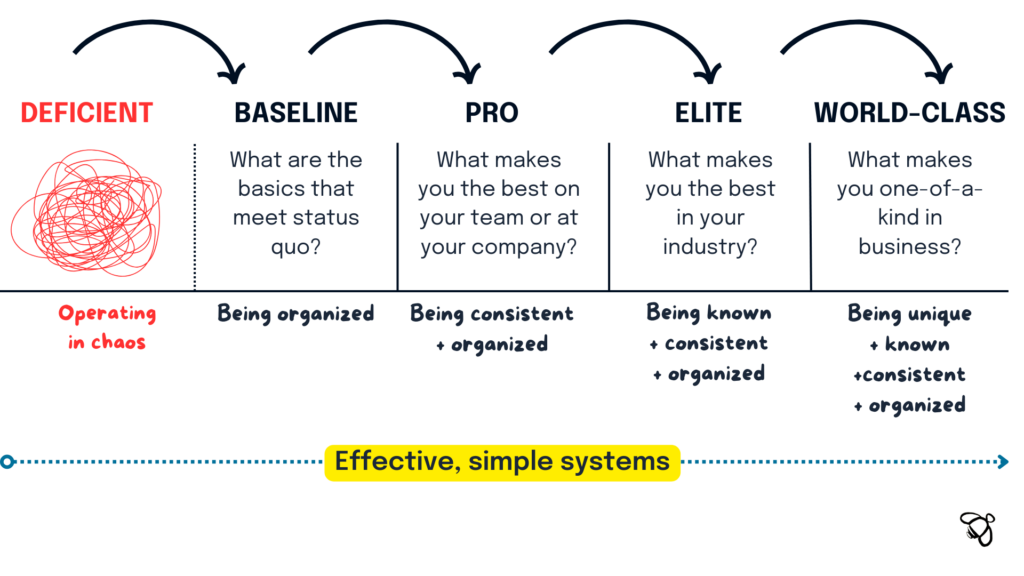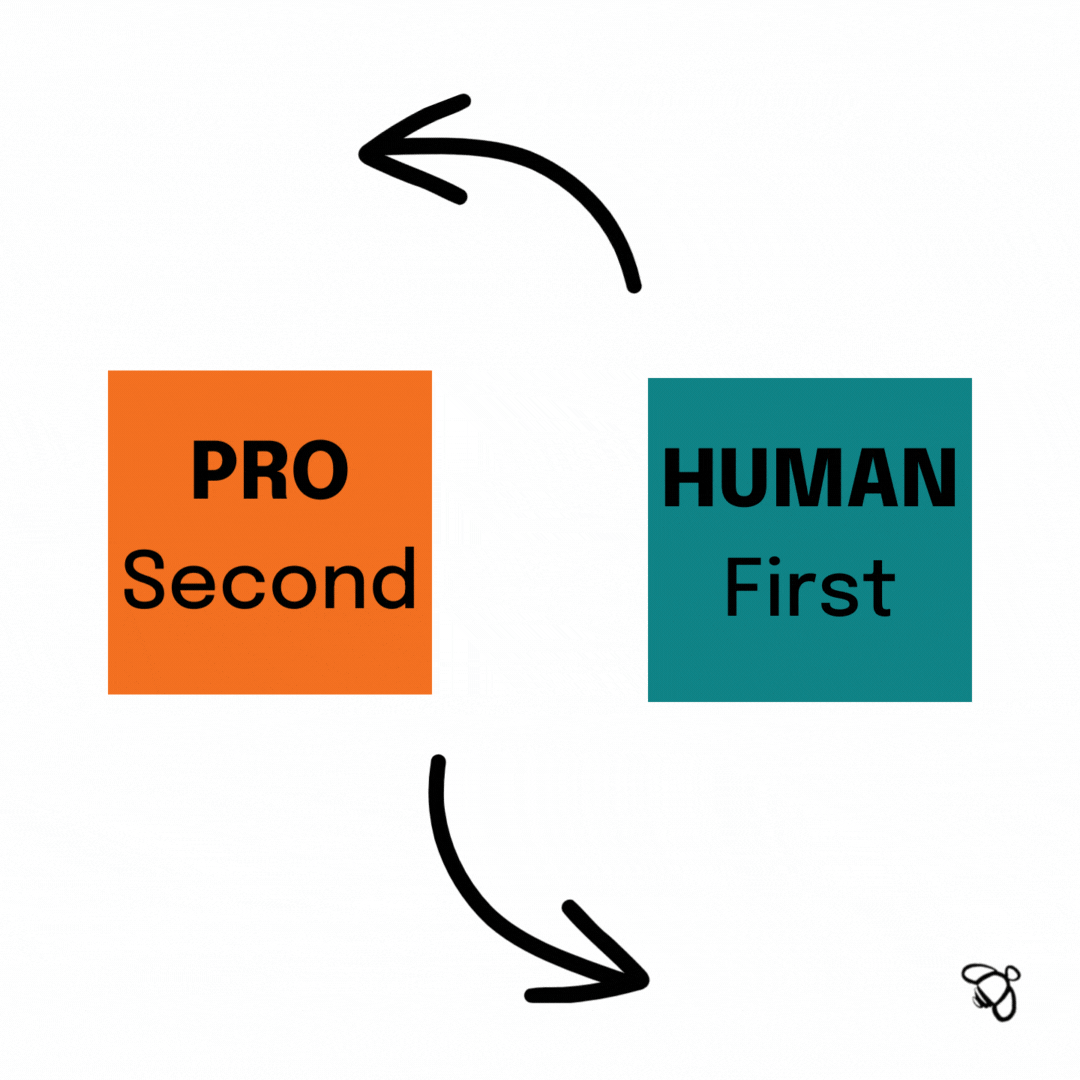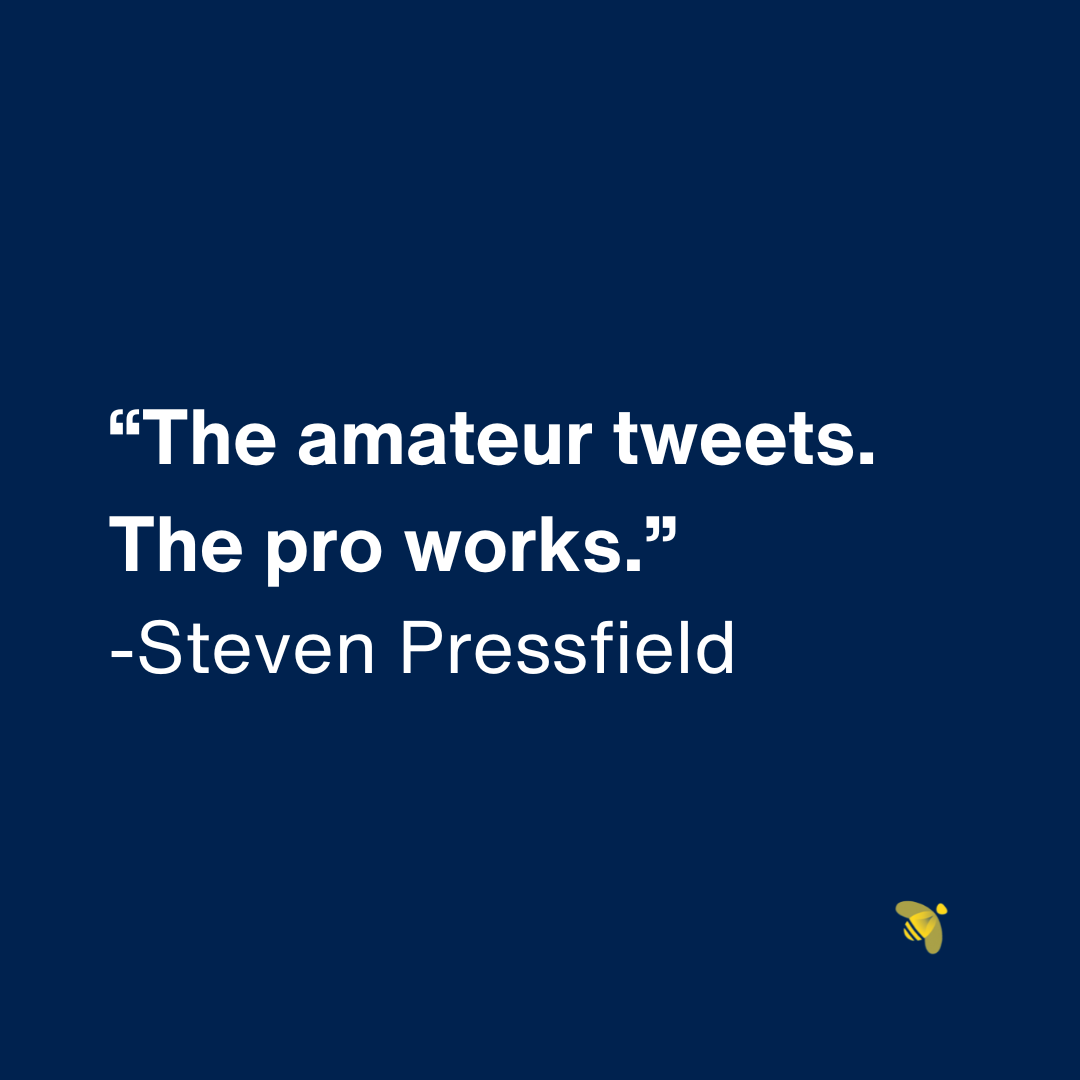⚡️ Today’s level up ⚡️
Today’s edition deconstructs a simple framework to help you calmly become a world-class performer.
Let’s go!
Read time: <9 minutes
If you missed last week, read it here.
Making the leap doesn’t have to be chaotic
The bottom line upfront: A lot of revenue generators I meet are operating in what I would classify as a “deficient” state. A few minor changes can make major improvements to generate powerful momentum that eventually delivers world-class performance.
Let’s use The High-Performance Framework to illustrate how it works.

What deficient looks like and how to escape it
Description: This is a performer who is behind the curve because they’re operating in chaos. The best adjectives that describe this state would be:
• Unaware
• Paralyzed
• Overwhelmed
It’s going to be impossible to create value in this state. Because it feels like so much is coming at you at once, the mistake that keeps performers in this state longer than necessary is hoping, wishing, or blindly working yourself to the bone.
Let’s use an example outside of sales.
Think of money management. The person who is in debt and living paycheck to paycheck thinks there will be some outside force that will change their state. Maybe they even partake in bad habits, hoping a night at the poker table or playing the lottery each week will change their fortunes (literally). However, this thinking just keeps them in a deficient state…in fact, making things worse because more money is going out the door than coming in until deficiency turns to bankruptcy.
The best first step for this person would be to get a handle on their spending. Guessing isn’t good enough. They have to be precise.
I see it happen all the time in sales. The seller is focused on everything that is “going wrong” and is not aware of what’s really happening. They think more outreach will be the cure, but they don’t even know if their outreach is any good, if their point of view is relevant, or if there are easier ways to connect with their target audience.
Exit criteria: The first step to stopping the paralysis and overwhelm is to become aware of your current situation – is it a professional problem or a human problem, or both?

Where most performers fall short is only focusing on the professional side. They think more work will treat the symptoms when actually there could be human factors causing the deficiency – relationship troubles, poor sleep, or not taking enough breaks. That’s why one of my core principles is always Human First, Professional Second.
The way I like to think about it is like a smartphone. The human carries the battery, and the pro operates the apps. So if your human side is depleted then the battery will drain, and the apps won’t function properly…or it all.
Once you identify and treat the things that are depleting your human side, it’s time to get crystal clear on your professional performance. Yes, we have access to all kinds of dashboards in sales, but what do pipeline and activity numbers really tell us? What are the skills we’re deficient in? That’s where you want to dive deeper.
Tools that can help:
▶ Track Your Win Rate (and other key metrics)
▶ Identify Your Sweet Spot Accounts
What baseline looks like and how to progress from it
Description: This is a performer who is doing the basics to meet the status quo. I hesitate to use quota, as we know that number is not always a realistic target, so reaching 100% to quota doesn’t necessarily translate to baseline, even though most employers would like you to think that way.
A truer baseline from a revenue generation standpoint is the median quota attainment of the team. So if you are on a ramped team of 10, and you achieved 56%, but the team as a whole was 53% to quota, then you were above baseline for your team.
That’s why tying our self-worth too closely to things like quota leaderboards and President’s Club can be a slippery slope.
A Purposeful Performer is more focused on precision, not status.
The key ingredient for a baseline performer is being organized. Their calendar is a source of peace, not stress. They understand their capacity, from both a human and professional standpoint. When they need to act, the right information is available at their fingertips. They don’t waste time or stress over looking for things. When it’s time to work, they work. When it’s time to shut down, they stop.
Great adjectives that describe the baseline performer are:
• Eager
• Organized
• Trustworthy
The baseline performer gets into trouble because they are so organized. Trust in them is high, so they become susceptible to people constantly asking for their help. It’s easy for the baseline performer to want to help everyone because it makes them feel important. But being a people pleaser will keep them locked in mediocrity.
Exit criteria: To elevate out of baseline performance, you have to be more than just an organized and efficient worker. You need to set higher standards for yourself, create boundaries (by saying “no” more than “yes”), and set up a system of self-reflection and improvement.
Tools that can help:
▶ How to make better decisions (and say no more)
What pro looks like and how to progress from it
Description: This is the performer who is clearly the best on their team, or even in the entire organization. They consistently win new business or grow existing accounts. They could swap companies and with enough time, deliver at the same level.
The best adjectives that describe the pro performer are:
• Reliable
• Adaptable
• Consistent
The pro is not only highly organized but is extremely mindful of the finite resources of time, energy, and attention and is obsessed with protecting them. They have clearly connected the dots between what their time is worth and pursuing activities and accounts that drive their energy up while eliminating ones that drain them. They are also very good at avoiding distractions and creating sophisticated systems to do so.

Exit criteria: Although the pro can live a nice lifestyle and continue doing their thing for a long time, there is still room to grow for someone who is eager to create optionality and see how far their skills and curiosity can take them.
Tools that can help:
▶ Manage your time effectively
▶ Manage your energy effectively
▶ Manage your attention effectively
What elite looks like and how to progress from it
Description: This is the performer who is well-known in their industry. Leaders in other companies know who they are (and want to hire them) and other sellers look up to them (and aspire to be like them). They are winning major transformation deals that cause ripple effects. When incumbents get displaced by their work, the losing team does a closed/lost analysis, and their name is mentioned.
Great adjectives to describe the elite performer are:
• Creative
• Impactful
• Innovative
The elite performer has transcended beyond status games. They are playing a more fun game – one built around making an impact. They are constantly challenging themselves and others to play bigger, but without blowing things up. They don’t treat themselves like a top performer; they think of themselves as a brand.
They’re more interested in driving transformative change, lifting many more up than just themselves. They understand very clearly what makes them unique and stack their skills up in a way to compliment one another. They’re obsessed about scaling their impact using systems, not raw talent or insane hard work. They’ve been able to figure out how to pierce some other dimension where their knowledge and motivation seem unworldly.
Exit criteria: When chasing the next big thing no longer excites them, it’s their clue that it’s time to create something entirely new altogether.
Tools that can help:
▶ Be confident in paving your own way
What world-class looks like
Description: This performer is now playing an entirely different game all together. They have a hard time even describing their vision because others find it hard to relate to. They are locked in completely on what makes them unique, and they obsess about tripling down on that skill.
They think in terms of scale. They think in terms of creating new categories and things that don’t exist in the world today. They are fond of the power of leverage and don’t waste energy on things that don’t move them closer to making dreams happen.
They understand what got them to the elite zone will not be what takes them to world-class – they have to create something new altogether. Money is not something to chase, it’s a tool that speeds things up.
Here are great adjectives of a world-class performer:
• Visionary
• Iconoclast
• Unshakeable
Exit criteria: Sorry folks, this is the end of the road! Be content and grateful when you make it here.
Tools that can help:
▶ Build leverage and create outsized value
That’s a wrap. Curious, what did you think of this one?
Here’s how I can help you right now:
1 | Unlock the 7 Figure Seller OS
Learn how to use design and systems thinking to become a 7 figure seller. There are 3 options to allow you to customize your learning journey.
2 | Download The 7 Figure Open Letter
Get the creative strategic selling strategy that landed a $5.9M deal with a top 4 major global airline. Bonus inside!
3 | Book a 1:1 coaching session right now
You can book a 60-minute coaching session with me (although the Pro option above in #1 provides access to 1:1 coaching with me at a 70% discount).

